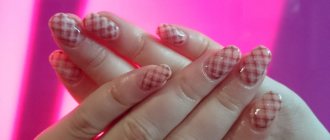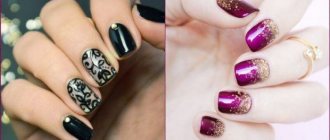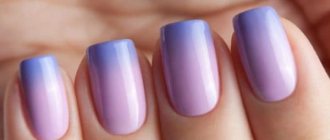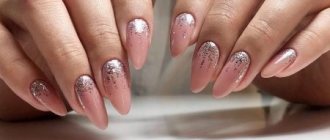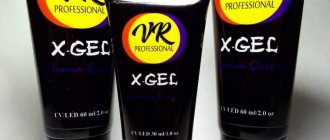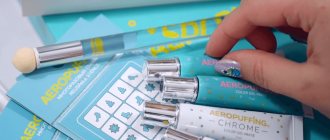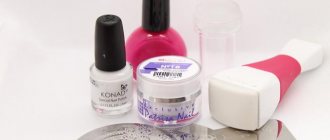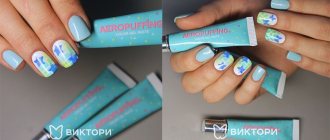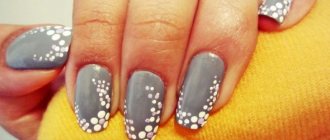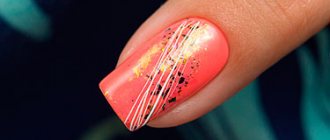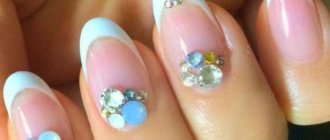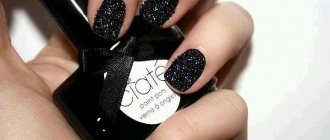One of the achievements of the nail industry that has made women's dreams come true is gel polish. How it differs from regular varnish and gel, what types of gel polish there are, its advantages and disadvantages and much more - in our material.
What is gel polish
Gel polish is a nail coating that combines the best of gel and polish. This resulted in a durable coating with a wide choice of colors.
The gel polish contains photoinitiators, which are responsible for rapid drying of the product under the influence of UV rays; a substance that promotes the formation of a film that increases the durability of the coating; various additives and diluents that affect the texture of the composition and strengthen the nails, as well as pigments responsible for the color of the gel polish.
Unlike regular varnish, which has a short service life - only two to three days, after which it wears off and loses its shine, takes a long time to dry and is easy to remove, gel polish has a long durability (up to three weeks) and removal features.
The gel polish system requires the use of special UV lamps, which trigger the polymerization process, due to which the polish dries in a matter of seconds and minutes. This feature is reflected in the design of the bottles, which differ from ordinary varnish. Gel polish always has reliable packaging; the bottles are opaque, which allows you to protect the composition from exposure to UV rays.
Unlike extension gel, gel polish cannot serve as a means of nail lengthening; it is used only for long-lasting and bright color.
The characteristics of the composition also dictate some features of the application, carried out in accordance with the developed technology. In addition, the coating requires the presence of special tools and equipment, specialized materials.
The coating removal procedure also has a number of features and must be carried out in strict accordance with technology. Failure to follow the application steps and removal procedure techniques can lead to a decrease in the durability of the coating, material detachments, and damage to the nail.
Soak Off - what is it?
Many girls wonder what Soak Off is, because the translation from Google translator turns out to be complete nonsense. What this actually means is that now the gel polish can be removed using the soaking method, you no longer need to file it off! Translation in another way is soft deletion. For this purpose, special liquids for removing Soak Off Remoover gel from different manufacturers (Illusiob, Silcare, Kodi, .ibd and others) are suitable, although some girls claim that it can be removed with ordinary acetone and similar cheap liquids. When producing such varnishes, polyurethane is used instead of polymers and monomers, allowing for “soaking”.
To remove Soak Off gel polish you need to follow several steps, but please note that the instructions for individual liquid manufacturers may differ:
- file the surface of the nail with a file until it is rough; there is no need to remove the entire layer of varnish with a file (in some systems, filing may not be necessary);
- soak your nails in remover;
- after the time has passed, using a pusher or an orange stick, push the liquefied remaining material from the cuticle towards the free edge of the nail;
- place your hands in the liquid again for 5 minutes;
- remove the remaining material again;
- wash your hands well with soap;
- Apply moisturizer, oil or lotion to cuticles and hands.
Some gel systems require Soak Off Remoover to be heated by placing the container in a large container of hot water or heated sand. Carefully read the instructions for your product!
What is the difference between gel polish and shellac
Often these concepts are confused and lead to confusion. This is due to the history of the product’s appearance on the market. In 2010, the well-known company CND, which produces products for manicure and pedicure, introduced a new product - gel polish, a composition that combines the advantages of gel and varnish. The product was released under the name Shellac. Subsequently, the technology became popular, other companies began to produce gel polishes under their own names, but the name of the first product became a household name and all brands of gel polishes were dubbed shellac. Thus, gel polish is the name of the coating, and shellac is a type of gel polish from the CND company, which became the first product on the market.
Single-phase varnish
A novelty in the nail art industry are single-phase coatings. One step color gel polish is a 3-in-1 nail coating product: a base base, directly colored varnish and a fixative. It is enough to apply the required number of layers and the manicure is ready. A wide range of colors will allow you to choose a product for everyday and formal manicure. In addition, the manufacturer offers a colorless transparent coating. Some people use it as a base for a design, others simply visually strengthen their nails.
Advantages of One step color:
- The time required to perform a manicure is reduced.
- The varnish is applied in a thin layer, the nails look natural and are enriched with oxygen.
- Cost-effective - you buy one product instead of three.
- The durability of single-phase varnish is up to 4 weeks.
Variety of Gel Polish
What types of gel polishes are there?
Gel polishes are divided according to application features.
- Single-phase is a combination of three elements of gel polish in one bottle: base, color coating and top.
- Two-phase is a bottle whose composition combines the properties of a base and color coating, as well as a top coating, sold independently.
- Three-phase system - each train goes separately.
The maximum result, implying long-term durability of the coating and brightness of color, is ensured by a three-phase system. A high-quality base coat helps strengthen the nail, evens out its surface, hiding possible defects, and extends the life of the coating. A high-quality top gives additional durability and is responsible for perfect highlights.
The following types are also distinguished:
- Gel polishes of different colors in one tone.
- With sparkles. Glitter and glitter of various sizes can be added to the composition of the gel polish - from colored dust to large sparkles.
- Camouflage. Gel varnishes in natural shades for French manicure and nude style.
- Thermo. Contains particles that change color at different air temperatures.
- Cat's eye. With its help, fancy patterns are created that arise through the use of a special magnet and the content of metallized particles.
- Chameleon. Shimmers when the lighting changes.
- Craquelure. Effect of cracking, artificial aging.
Reviews of gel polishes “Saviland Gel Polish”
Maria's review:
I ordered varnishes from Aliexpress in a volume of 7 ml. I chose two colors: pearlescent (8503) and gray (8022), they seemed very pleasant to me. Now I’ll tell you about everything in order. The bottle is matte black, the brush is ordinary, which I really liked. When applied to the nail, the varnish does not flow and dries quickly - in just 30 seconds. The coating lasted 2.5 weeks on the nails (I took it off because my nails were peeling off). The base and top were taken from another company.
Review from Evgeniya:
I took two shades 103 (delicate purple) and 104 (delicate pink). These two tones are great for a French jacket. They apply well to nails, do not run, and dry quickly. I was very surprised that after 10 days of wear there are not a single chip on the nails (to be honest, I thought that the quality would be much worse). In general, I decided that for this price I would order more.
Feedback from Nadezhda:
I ordered white, white with glitter, purple with glitter and blue gel polishes from Ali. Of all the shades, I didn’t like white. It doesn't dry well. White with glitter on nails does not look very nice (in general, the shade is so-so). But blue and purple with glitter are wonderful varnishes.
Advantages and disadvantages of coating
Pros of coverage:
- Long lasting durability compared to conventional. The durability of a gel polish coating is 2-3 weeks, compared to 2-3 days for regular polish. Provided that all the nuances of applying the coating are followed, as well as the use of high-quality materials, the coating can be worn until the nails grow so long that the manicure takes on a sloppy appearance.
- It is important to note that nails under gel polish grow much faster, since the composition strengthens the nails and protects them from harmful influences.
- The coating dries quickly. Regular nail polish required at least half an hour to dry completely, while gel polish dries in thirty seconds to two minutes, depending on the brand and color density. Immediately after applying the coating, you can go about your normal activities without worrying about the varnish smearing.
- Gel polish is a color that does not lose its saturation during wear and has much greater brightness compared to regular polish. A huge palette of colors allows you to choose any shade.
- The coating is highly durable, it is not easy to scratch, the gel polish will not wear off after a couple of days and will not deteriorate after washing dishes.
- Gel polish coating allows you to make any nails beautiful, well-groomed, and smooth. Gel polish smoothes the surface of the nail, strengthening it.
- Gel polish coating gives free rein to your imagination when creating designs. Rhinestones, sparkles, stickers, artistic painting, airbrushing, French, moon manicure and much more can be done on nails with gel polish. Any design will look beautiful and delight you with its durability, brightness and shine until the coating is removed.
- Unlike regular polish, gel polish does not have a pronounced odor and the procedure is easy and comfortable.
- You can make gel polish yourself, having some knowledge about the manicure process and technology, as well as taking care of purchasing the necessary materials and tools.
Disadvantages of gel polish
- Cost of coverage in the salon. High-quality coating, performed by an experienced, highly qualified specialist, using professional tools and materials, with the help of expensive associated equipment, cannot be cheap. But a professionally performed manicure will certainly please you and will not harm your nails.
- Violation of stages, improper removal, use of low-quality or inappropriate products can harm your nails.
- Even a properly performed, high-quality covering cannot be worn constantly. Nails should rest.
- Despite the harmlessness of the coating, gel polish can cause an allergic reaction.
- In rare cases, individual intolerance to any components of the gel polish is possible.
- It is not always possible to apply the coating carefully at home. In addition, a lack of knowledge leads to a violation of the coating and removal technology, which leads to fragility and damages the nails.
- Gel polish is not suitable for those who like to frequently change their looks, or who get tired of wearing one shade for 2-3 weeks.
Color palette and cost
When choosing nail polish, girls first of all pay attention to the quality of the product and only then to the colors offered. “Gel Polish” produced by the Saviland brand has over 31 colors and shades. As they say, there is plenty to choose from. All colors are colorful and quite varied. The cost of Gel Polish varnishes ranges from 140-180 rubles per 15 ml bottle. It all depends on the seller, his rating and popularity.
This amount of coverage will be enough for home use, but if you do manicures for clients, it is better to purchase a larger bottle. In addition, Chinese sellers often organize various promotions, for example, they give a discount on orders over 3 bottles of varnish.
The palette is like this:
Photo: Saviland varnish palette
Gel polish at home
If you decide to perform the procedure for applying gel polish yourself, study several video tutorials in advance, and also prepare everything you need. We will consider the technology of applying a three-phase composition.
What you will need Prepare everything you need for a regular manicure, be it an edged, European or hardware manicure, buy color, base and top coats, lint-free napkins, files and buffers in advance. Make sure you have an ultraviolet or LED lamp - without it the coating will not dry. It's also good to have cuticle oil.
How the coating is performed
- If necessary, remove the old coating, completely cleaning the nail.
- File the free edge of the nail, giving it the desired shape. Avoid using metal files. File only on dry nails; try not to soak them before the procedure. This will avoid delamination.
- Remove the cuticle. It is better to use special products for this, regular use of which will greatly facilitate manicure. Apply the product to the cuticle, wait a couple of minutes, carefully move the skin away and carefully remove any remaining product.
- Grind the nail, especially carefully treat the areas near the cuticle. Try not to damage the nail, avoid pressing. The task of this stage is to remove shine for better adhesion of the material to the natural nail. After sanding, carefully remove dust with a brush.
- Degrease the nail with a professional product; in extreme cases, you can use alcohol for this purpose.
- Apply a thin layer of base coat to each nail. Be careful not to let the base come into contact with the skin around the nail. When applying, be sure to work around the loose edges, sealing them. Dry the nail under the lamp.
- Start coating with color. Do not shake the bottle before applying as this may cause bubbles and uneven coverage. Apply a thin layer and let it dry in the lamp. Reapply coat. Each layer should dry for two minutes if you are using a UV lamp, and thirty seconds if you are using an LED lamp.
- Finally, apply a top coat to your nails, carefully treating the free edge, and dry in a lamp. If the top coat has a sticky layer, carefully remove it with a lint-free cloth moistened with a degreaser.
- The final stage is treating the cuticle with moisturizing oil, this will give the manicure a well-groomed look. Rub in the oil and remove any remaining residue with a napkin.
Three phase system
The three-phase gel polish application system is the most difficult to perform. However, she is also the most persistent.
The first phase is applying the base. The base coat minimizes the appearance of flaking and chipping. The base also allows you to level and hide imperfections of the nail plate. In this case, the final result will be more accurate and will be pleasing to the eye.
The second phase is applying gel polish. If you are not satisfied with the result after the first application or want to try the craquelure effect, you can do two layers.
The third phase is applying the top coat. The top serves to protect the manicure from minor mechanical damage, chips, and scratches. It also adds shine and can smooth out uneven nails.
Two-phase system
This system is somewhat simpler. Here there is no need to apply a foundation (base). All that remains is gel polish and top coat. Otherwise everything is the same. But this system has not gained much popularity in our country.
Single phase system
In this case, gel polish combines three products at once: the gel polish itself, the base and top coat. We simply apply the three-in-one product to our nails and get a good manicure.
But do not forget that it is somewhat less durable compared to the three-phase method of applying gel polish. On the other hand, the clear advantage of the last two systems is the time that you will need to spend to get the result.
We fix each layer in any of the three systems by drying it in a lamp!
Rules for maintaining coverage
To make your gel polish last a long time, follow simple rules:
- Before the procedure, try to avoid greasy hand skin care products; do not wet your hands an hour and a half before the procedure.
- For about an hour after the procedure, try not to get your hands wet.
- Despite its durability, gel polish is susceptible to changes under the influence of various household chemicals, which shorten the life of the coating. To preserve your manicure and protect the coating from powders, dishwashing detergents and other chemicals, use gloves.
- Don't skip the correction. After 2-3 weeks, as the nail grows, it will begin to experience overload, which can lead to breakage, disruption of the nail architecture and other problems.
- Without the appropriate skills and experience, avoid removing the coating yourself.
- Give your nails a rest. It is advisable to give your nails about a month to recover after 4-5 coats.
